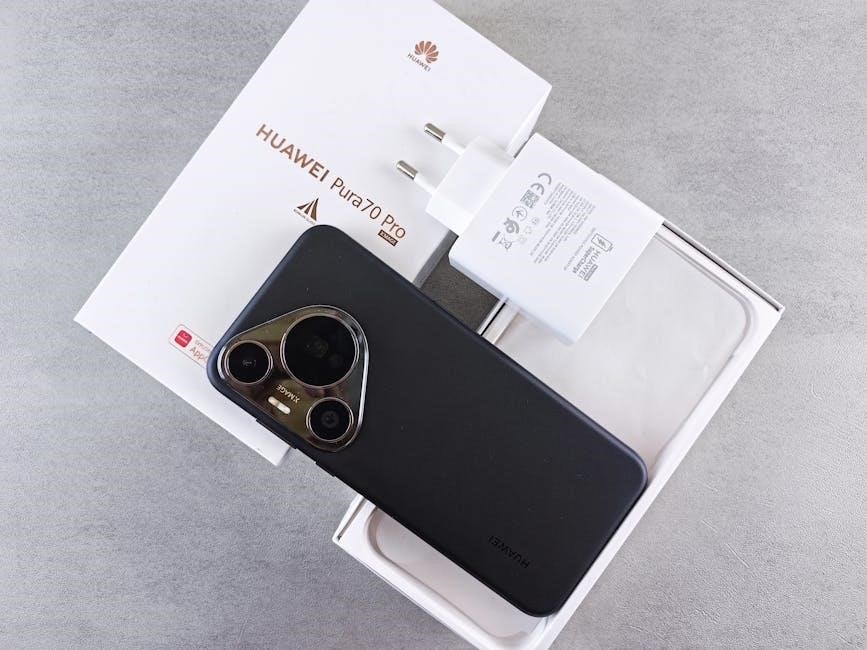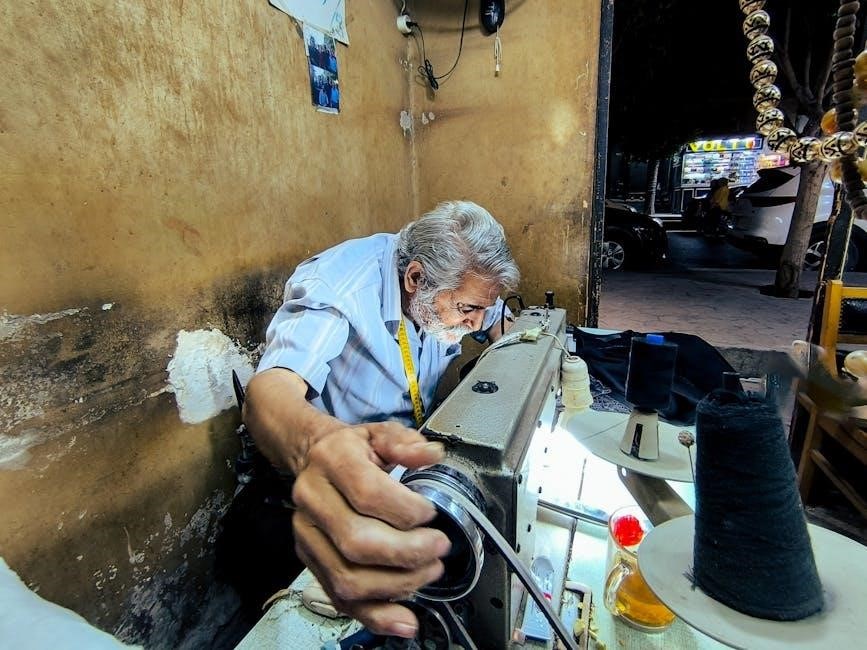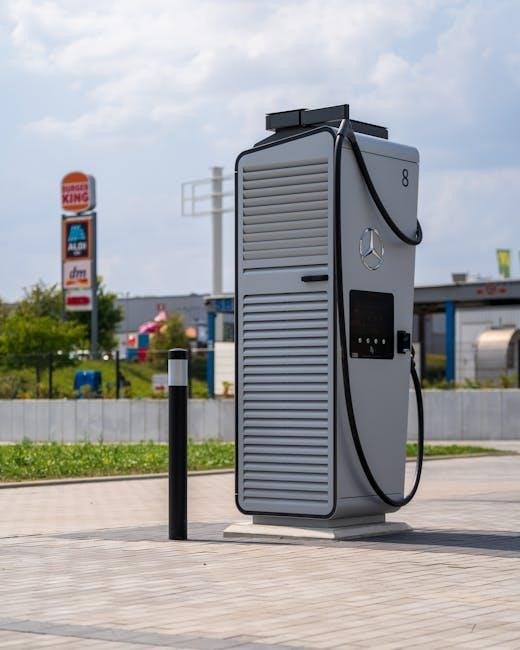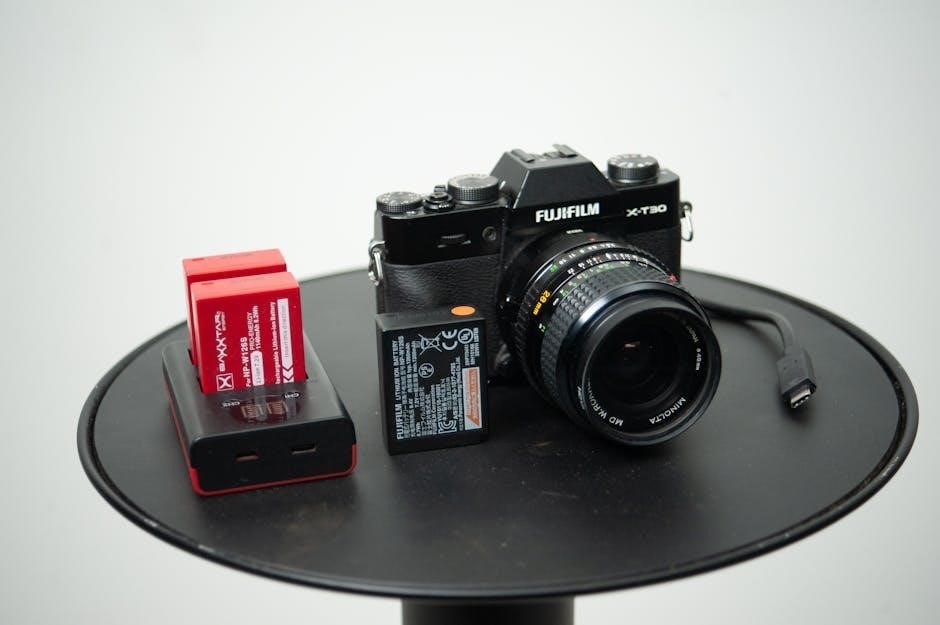Welcome to the Duralast Charger Manual, your comprehensive guide to understanding and using Duralast battery chargers․ This manual covers essential safety tips, model-specific instructions, and troubleshooting techniques to ensure optimal performance and longevity of your batteries․ Whether you’re a novice or an experienced user, this guide will help you master the operation of Duralast chargers, including models like the DL-250D, DL-4D, and DL-8D․ Learn how to charge safely, maintain your equipment, and resolve common issues with ease․
1․1 Overview of Duralast Chargers
Duralast chargers are a trusted solution for battery maintenance and charging, offering a range of models to suit different needs․ From manual to automatic chargers, Duralast provides reliable tools for automotive, marine, and recreational applications․ Designed with user-friendly features, these chargers ensure safe and efficient battery care․ Models like the DL-250D, DL-4D, and DL-8D cater to various requirements, offering multiple charging modes and advanced safety features․ Whether you need a portable power station or a compact maintainer, Duralast chargers deliver consistent performance, ensuring your batteries remain in optimal condition․ Their durable construction and innovative technology make them a preferred choice for both professionals and DIY enthusiasts․
1․2 Importance of Using a Manual
Using a Duralast charger manual is essential for safe and effective operation of your battery charger․ It provides detailed instructions to avoid misuse, which can damage the charger, battery, or cause safety hazards․ The manual includes step-by-step guides for installation, operation, and maintenance, ensuring you understand how to charge batteries correctly․ Additionally, it outlines safety protocols and troubleshooting tips, helping you identify and resolve common issues․ By following the manual, you can optimize the performance of your charger and extend the lifespan of your batteries․ It serves as a comprehensive resource, tailored to your specific Duralast model, ensuring you get the most out of your charger while maintaining safety and efficiency․

Safety Precautions and Guidelines
Always wear protective gear and follow safety protocols when using Duralast chargers․ Ensure proper ventilation, avoid overcharging, and keep flammable materials away to prevent accidents and ensure safe operation․
2․1 General Safety Tips

Always wear protective gear like gloves and safety glasses when using Duralast chargers․ Ensure the charging area is well-ventilated to avoid inhaling harmful fumes․ Never overload the charger or use damaged cables, as this can cause electrical hazards․ Keep flammable materials away from the charging station․ Avoid touching both terminals of the battery or charger with bare hands to prevent electric shock․ Ensure the charger is unplugged before connecting or disconnecting batteries․ Follow the manual’s guidelines strictly to prevent overcharging, which can damage the battery or pose a fire risk․ Regularly inspect the charger and cables for damage or wear․ Store the charger in a cool, dry place when not in use․ Always monitor the charging process and keep children away from the charging area․ By adhering to these safety tips, you can ensure a safe and effective charging experience with your Duralast charger․
2․2 Personal Safety Instructions
Always prioritize personal safety when using a Duralast charger․ Wear protective gear, such as gloves and safety glasses, to shield yourself from potential electrical hazards․ Avoid wearing loose clothing or jewelry that could accidentally contact terminals․ Ensure the charger is unplugged before handling batteries or cables to prevent electric shock․ Never touch both terminals of the battery or charger with bare hands, as this can cause injury․ If you notice any unusual odors, sounds, or sparks, stop the charging process immediately․ Keep children and pets away from the charging area․ Properly ground yourself to avoid static electricity discharge, especially in dry environments․ By following these personal safety instructions, you can minimize risks and ensure a safe charging experience with your Duralast charger․
2․3 Proper Handling of Batteries
Properly handling batteries is crucial for safety and efficiency when using a Duralast charger․ Always inspect batteries for signs of damage, such as cracks or corrosion, before charging․ Ensure the battery terminals are clean and free of debris to maintain a secure connection․ Use the correct cable clamps, with the red clamp for the positive terminal and the black clamp for the negative terminal․ Avoid overcharging, as it can damage the battery and reduce its lifespan․ Store batteries in a cool, dry place away from flammable materials․ For specific models like the Duralast DL-250D, follow the manufacturer’s guidelines for battery type and capacity․ Proper handling ensures safe and effective charging․

Understanding Duralast Charger Models
Duralast offers a variety of chargers designed for specific needs․ From the DL-250D manual charger to the DL-4D two-bank charger, each model provides unique features for optimal battery maintenance․
3․1 Duralast DL-250D Manual Charger
The Duralast DL-250D Manual Charger is a robust 250-amp, 12-volt charger designed for hands-on control over the charging process․ It features a wheeled design for portability and versatility․ With multiple charging modes, including 250-amp engine start, 50-amp boost, and 10-amp charge/maintain, it caters to various battery needs․ The rate selection knob allows users to choose the desired charge level, while the 135-minute timer helps limit charging duration․ Ideal for jump-starting dead batteries and maintaining battery health, the DL-250D is a reliable choice for professionals and DIY enthusiasts alike․ Its durable construction ensures long-term performance and reliability․
3․2 Duralast DL-4D Two-Bank Charger
The Duralast DL-4D Two-Bank Charger is a versatile and efficient charging solution designed to charge and maintain two batteries simultaneously․ With a compact and lightweight design, it is ideal for both home and professional use․ The charger features a 2-amp output, providing a steady and controlled charge for 6-volt and 12-volt batteries․ Its two-bank design allows independent charging of each battery, making it perfect for applications like lawn mowers, power sports vehicles, or marine batteries․ The DL-4D includes an automatic charging system that switches to float mode when the battery is fully charged, preventing overcharging and ensuring battery longevity․ A 6-foot power cord with onboard storage adds convenience, while a one-year warranty guarantees reliability․
3․3 Duralast DL-8D Automatic Charger
The Duralast DL-8D Automatic Charger is a reliable and user-friendly option for charging 6-volt and 12-volt batteries․ Its fully automatic design simplifies the charging process, making it ideal for both novice and experienced users․ The charger features an 8-amp output, providing a powerful yet controlled charge․ The DL-8D automatically detects the battery type and charge level, switching to a float mode once fully charged to prevent overcharging․ It includes a built-in spark suppression system for added safety․ Suitable for motorcycles, automotive, and marine batteries, this charger is a practical choice for maintaining battery health․ Its compact design and ease of use make it a reliable solution for home and professional applications, backed by a one-year warranty for peace of mind․
3․4 Duralast DL-1000 Portable Power Station
The Duralast DL-1000 Portable Power Station is a versatile and powerful tool designed for emergency situations and outdoor activities․ It combines a jump starter, air compressor, and portable power source, making it ideal for jump-starting vehicles, inflating tires, and charging devices․ With a 1000A peak current, it can quickly jump-start most vehicles․ The built-in air compressor is perfect for inflating tires, while multiple USB ports and power outlets allow you to charge smartphones, laptops, and small appliances․ Its rugged design and durable construction make it suitable for camping, emergencies, or roadside assistance․ The DL-1000 also features a built-in LED flashlight for illumination in dark conditions, ensuring reliability and convenience in various scenarios․ This portable power station is a must-have for outdoor enthusiasts and drivers seeking a reliable power solution․
3․5 Duralast DL-200D Battery Charger
The Duralast DL-200D Battery Charger is a robust and efficient solution for charging and maintaining 12-volt lead-acid batteries․ Designed for automotive, marine, and recreational applications, it offers a 200-amp engine start for quick jump-starting, a 50-amp boost mode for rapid charging, and a 10-amp charge/maintain mode to keep batteries topped off․ LED indicators provide clear charging status updates, while built-in spark protection ensures safety․ Its durable construction and user-friendly controls make it ideal for professionals and DIYers alike․ Suitable for maintaining marine batteries, recreational vehicles, and more, the DL-200D is a versatile and reliable choice for all your battery charging needs․
3․6 Duralast DL-2D Battery Maintainer
The Duralast DL-2D Battery Maintainer is a compact and convenient device designed to keep 12-volt batteries in optimal condition․ It features a trickle charging mode that delivers a gentle, consistent flow of current to maintain charge levels and prevent sulfation․ Ideal for vehicles parked for extended periods, such as seasonal cars, motorcycles, or recreational vehicles, this maintainer ensures batteries remain ready for use․ Its lightweight and compact design make it easy to store and transport․ Built-in safety features protect against overcharging and short circuits, ensuring a safe and reliable charging experience․ The DL-2D is a smart investment for extending battery lifespan and maintaining peak performance․
3․7 Duralast DL-15D Battery Charger
The Duralast DL-15D Battery Charger is a versatile and reliable charging solution for a wide range of 12-volt lead-acid batteries․ It offers a 15-amp output, providing quick and efficient charging for automotive, marine, and power sport applications․ The charger features a multi-stage charging process, including a quick boost to restore initial charge, a bulk stage to reach full capacity, and a trickle mode to maintain charge levels․ This ensures optimal performance and prevents overcharging․ Compact and lightweight, the DL-15D is easy to use and transport․ Its durable construction and user-friendly design make it a practical choice for both professional and DIY users, ensuring your batteries are always ready when needed․

Step-by-Step Charging Guide
This section provides a detailed, step-by-step guide on how to charge your battery safely and effectively using a Duralast charger․ Follow these steps for optimal charging․
4․1 Preparing for Charging
Before charging, ensure the area is well-ventilated to prevent hydrogen gas buildup․ Always refer to the Duralast charger manual to confirm compatibility with your battery type․ Wear protective gear like gloves and goggles․ Locate the charger on a stable, heat-resistant surface․ Check the charger for damage or loose connections․ Ensure the battery terminals are clean and secure․ Set the charger to the correct voltage and mode as specified in the manual․ Verify all safety features, such as overcharge protection, are functional․ If unsure, consult the troubleshooting section for guidance․ Proper preparation ensures a safe and effective charging process․

4․2 Connecting the Charger
Start by disconnecting the charger from the power source․ Attach the positive (red) clamp to the battery’s positive terminal and the negative (black) clamp to the negative terminal or a grounded metal surface․ Ensure the clamps are secure to maintain good contact․ For models like the DL-250D, use the rate selection knob to choose the correct charge level․ Plug in the charger and turn it on, verifying the LED indicators light up․ Avoid reversing the clamps, as this can damage the charger or battery․ Once connected, the charger will begin charging automatically․ Monitor the process to ensure it operates smoothly and safely․
4․3 Monitoring the Charging Process
Once the charger is connected, monitor the charging process closely․ Check the LED indicators on the charger, which typically show the current charging stage (e․g․, charging, maintaining, or complete)․ For models like the DL-250D, ensure the timer is set correctly if applicable․ Avoid overcharging by keeping an eye on the battery’s voltage or the charger’s built-in indicators․ If using an automatic charger like the DL-8D, the device will automatically switch to float mode when the battery is fully charged․ Periodically inspect the clamps and cables for secure connections and signs of wear․ Proper monitoring ensures efficient charging and prevents damage to the battery or charger․
4․4 Safe Disconnection
To ensure safety, always disconnect the charger properly after charging is complete․ First, turn off the charger and allow it to cool for a few minutes․ Next, remove the positive (red) clamp from the battery terminal, followed by the negative (black) clamp․ For models like the DL-250D, ensure the charger is unplugged from the power source before disconnection․ Never disconnect the clamps while the charger is active, as this can cause sparks or electrical issues․ Inspect the clamps and cables for damage before storing the charger․ Proper disconnection helps prevent accidents and extends the lifespan of both the charger and battery․

Troubleshooting Common Issues
Identify and resolve common Duralast charger issues by checking power connections, battery terminals, and cables․ Ensure proper operation by verifying settings and referring to the manual for solutions․
5․1 Identifying Common Problems
Common issues with Duralast chargers include faulty connections, incorrect voltage settings, and overheating․ Battery compatibility and improper charging modes can also cause malfunctions․ Check for loose clamps, damaged cables, or incorrect polarity connections․ Overcharging or undercharging may occur due to faulty sensors or improper timer settings․ Additionally, issues like blown fuses or tripped circuit breakers can interrupt charging․ Always refer to the manual for specific troubleshooting steps tailored to your Duralast model․ Diagnosing these problems early ensures efficient resolution and prevents further damage to your charger or battery․
5․2 Resolving Charger Malfunctions
If your Duralast charger malfunctions, start by disconnecting it from the power source and battery․ Check for loose connections or damaged cables, ensuring all clamps are securely attached․ Restart the charger after verifying proper connections․ If issues persist, consult the manual for model-specific reset procedures․ For models like the DL-250D or DL-8D, resetting the charger may resolve software glitches․ If the problem remains unresolved, contact a professional or the manufacturer for assistance․ Regular maintenance and adherence to safety guidelines can help prevent malfunctions․ Always prioritize safety when troubleshooting to avoid further damage or hazards․
5․3 Battery Charging Issues
Common battery charging issues include slow charging, overcharging, or the charger not recognizing the battery․ First, ensure the Duralast charger is set to the correct voltage and amp setting for your battery type․ For models like the DL-250D or DL-8D, check the charge mode selection․ If the issue persists, verify the battery’s age and health, as older batteries may not hold a charge․ Clean corrosion from terminals and clamps, as poor connections can disrupt charging․ If the battery is deeply discharged, allow the charger to run through its cycle․ Always refer to the manual for model-specific troubleshooting steps to resolve charging problems effectively․

Maintenance and Storage Tips
Regularly clean charger terminals and store in a cool, dry place․ Avoid extreme temperatures and moisture․ Proper storage ensures longevity and optimal performance of your Duralast charger․
6․1 Regular Maintenance

Regular maintenance is crucial to ensure the optimal performance and longevity of your Duralast charger․ Start by cleaning the charger terminals with a wire brush to remove dirt and corrosion, ensuring proper electrical connections․ Inspect the cables and plugs for damage or wear, replacing them if necessary․ Avoid overcharging by monitoring the charging process and using the correct settings for your battery type․ Store the charger in a cool, dry place away from direct sunlight and moisture․ For models with advanced features, refer to the specific maintenance recommendations in your Duralast charger manual․ Regular upkeep prevents malfunctions and extends the lifespan of your device․
6․2 Proper Storage Conditions
To maintain the performance and longevity of your Duralast charger, store it in a cool, dry location away from direct sunlight and moisture․ Avoid extreme temperatures, as they can damage the internal components․ Keep the charger away from flammable materials and ensure it is not in contact with any conductive surfaces․ Store the device in an upright position to prevent liquid leakage from the batteries, if applicable․ Always disconnect the charger from the power source and allow it to cool before storing․ For long-term storage, consider using a protective cover to shield it from dust․ Proper storage conditions ensure your Duralast charger remains functional and safe for future use․

7․1 Summary of Key Points
This manual provides a comprehensive guide to using Duralast chargers safely and effectively․ It covers essential safety protocols, step-by-step charging instructions, and troubleshooting tips to ensure optimal battery performance․ By following the outlined procedures, users can maximize the longevity of their batteries and maintain reliable power solutions․ The guide emphasizes proper handling, model-specific features, and routine maintenance to prevent common issues․ Whether you’re a novice or an experienced user, this manual equips you with the knowledge to operate Duralast chargers confidently, ensuring your batteries remain in peak condition for years to come․
7․2 Final Tips for Optimal Use
For the best experience with your Duralast charger, always follow the guidelines outlined in this manual․ Regularly inspect cables and connections to ensure they are free from damage․ Store batteries in a cool, dry place when not in use, and avoid overcharging, as it can reduce battery lifespan․ Monitor charge levels closely, especially for sensitive or deep-cycle batteries․ Keep the charger away from flammable materials and ensure proper ventilation during use․ Refer to your specific model’s manual for tailored instructions, as features may vary․ By adhering to these tips, you can ensure safe, efficient, and long-term performance from your Duralast charger․